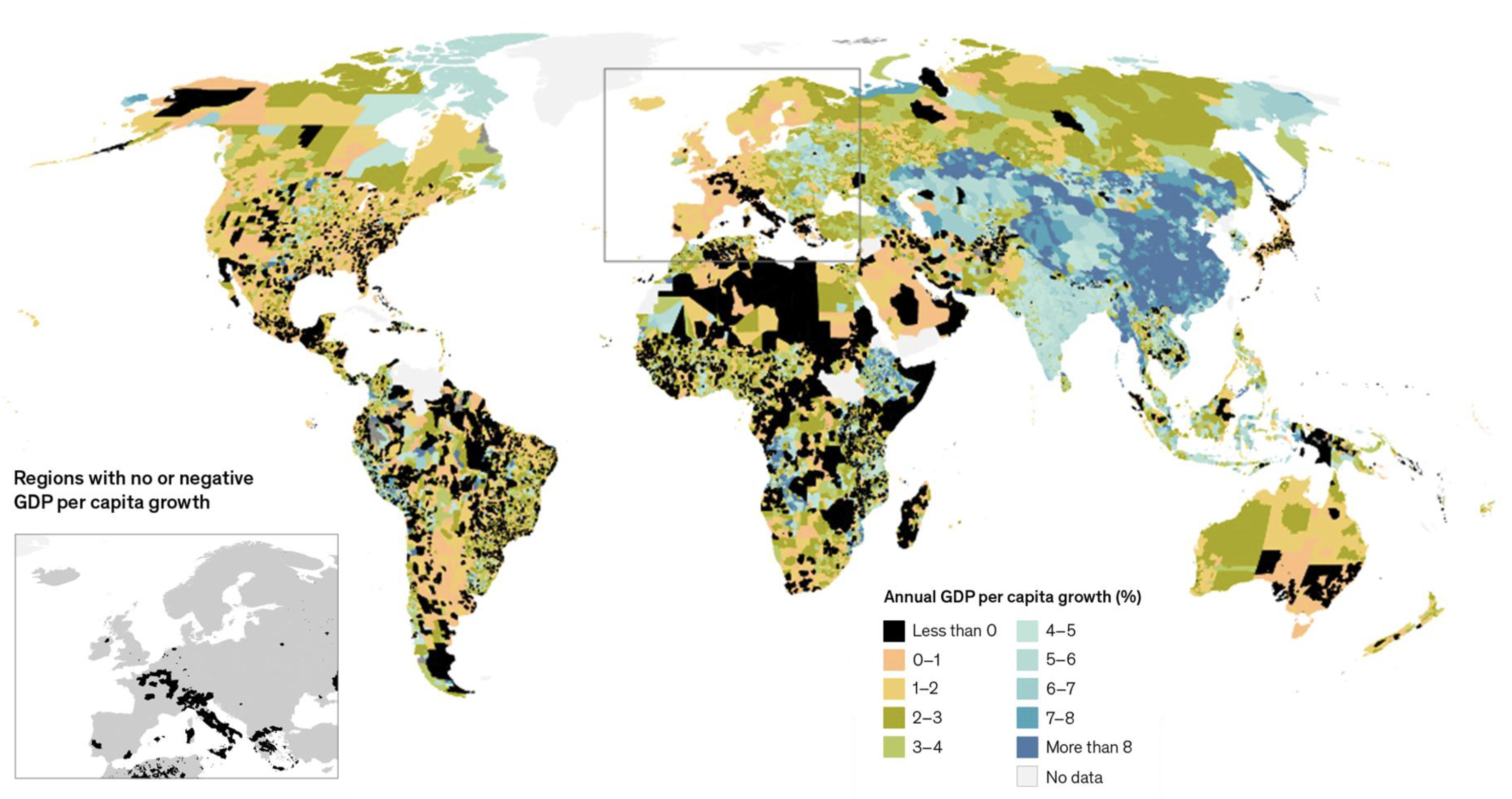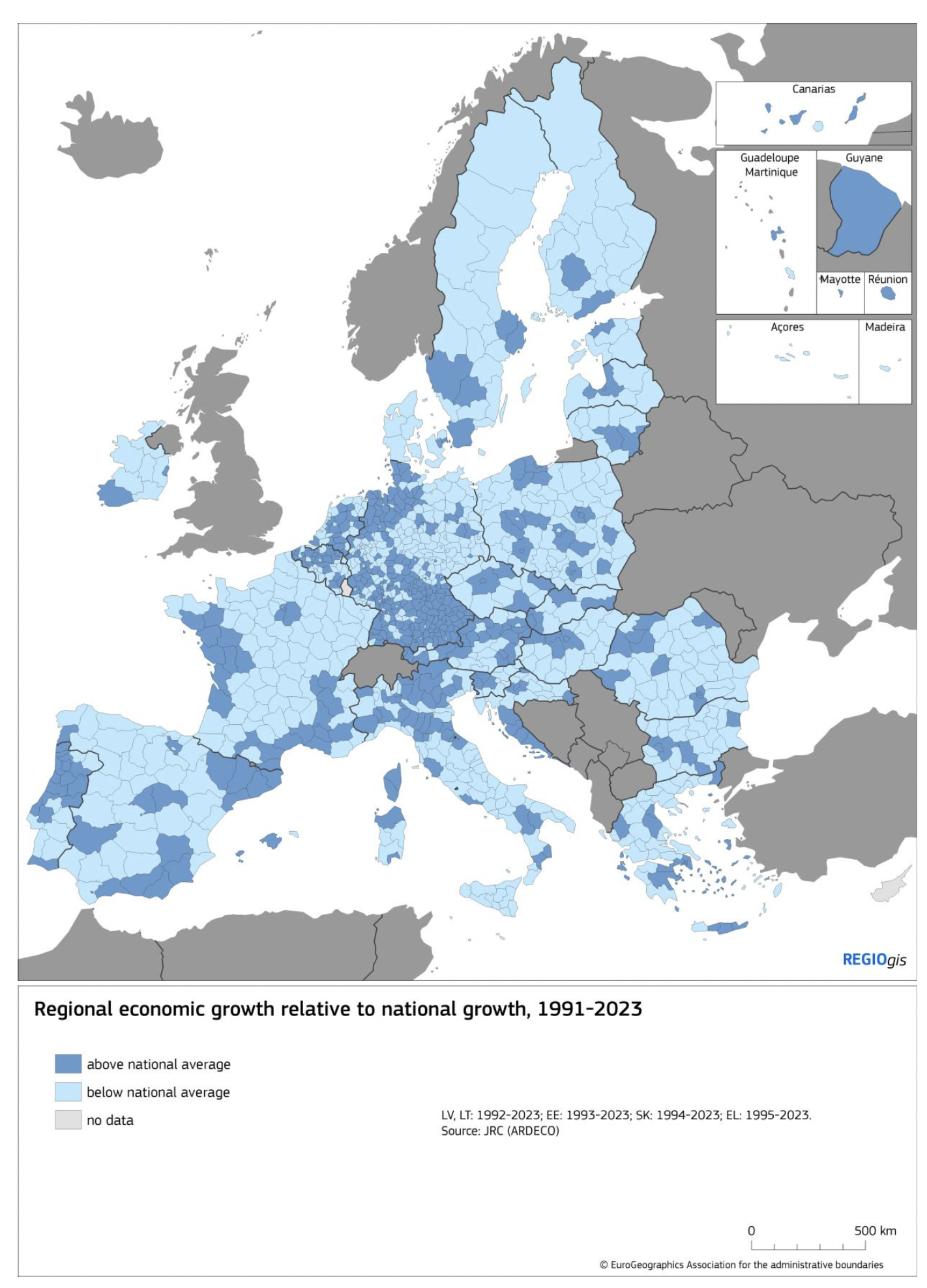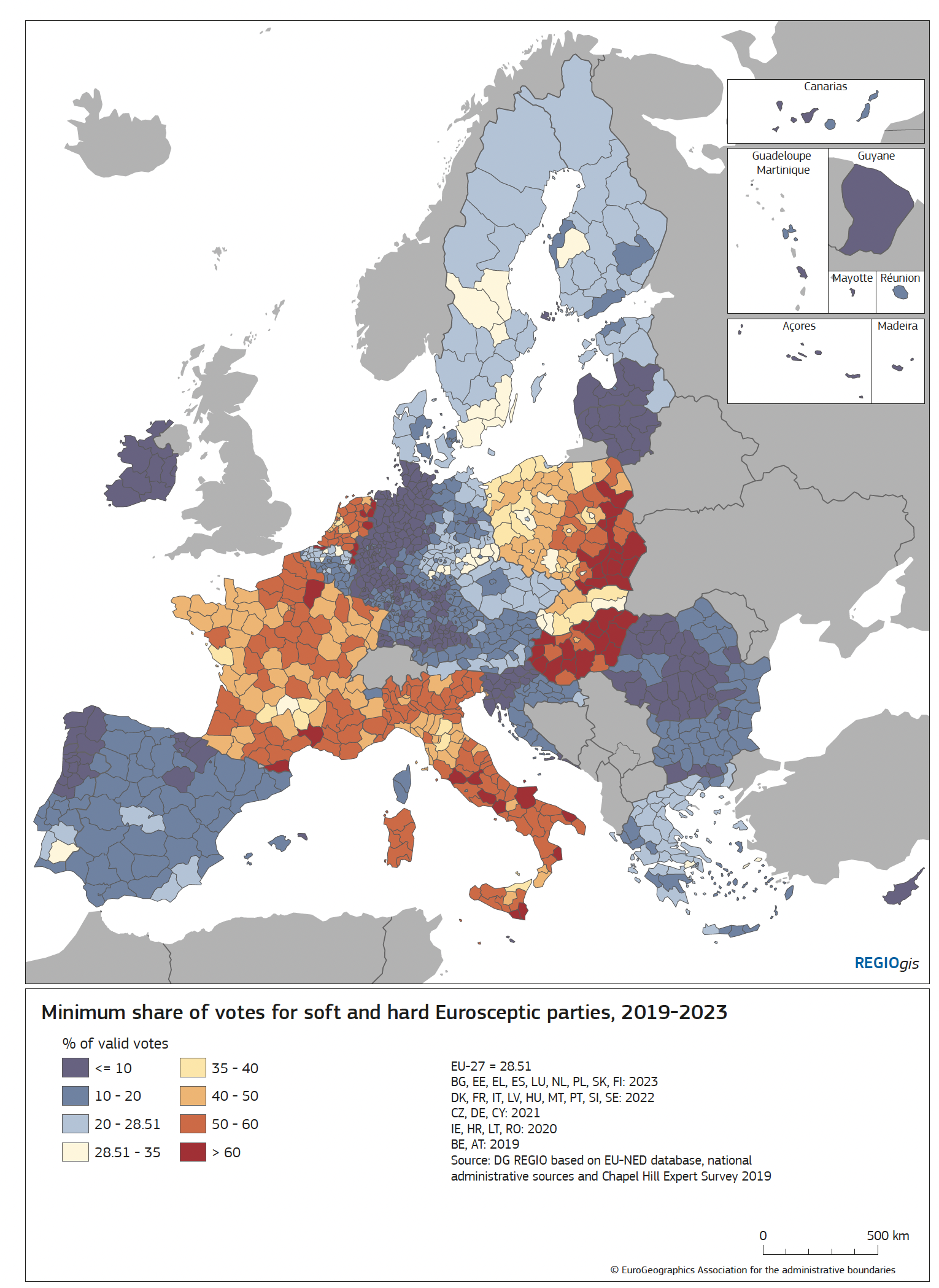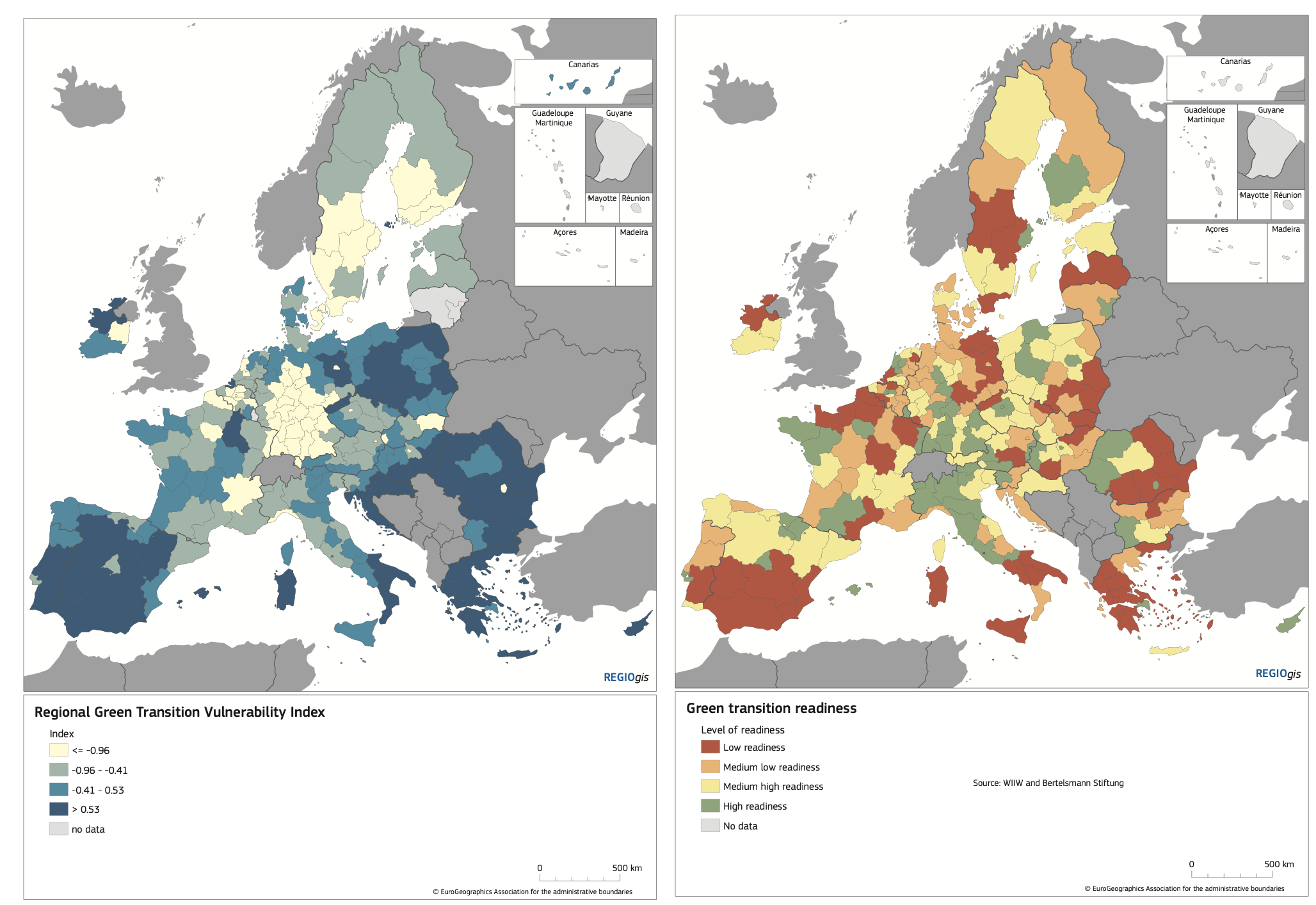Author’s note: The column was written on behalf of the High-Level Group on the Future of Cohesion Policy.
The report of the High-Level Group on the Future of Cohesion Policy, Forging a sustainable future together: Cohesion for a competitive and inclusive Europe, was launched on 20 February 2024 in Brussels. This is the first exercise of this calibre since the ‘Barca Report’ (Barca 2009). Its launch marks a key moment in the EU’s quest to redefine its approach towards achieving a better and more balanced and inclusive future for all its citizens. The report is the culmination of efforts by a diverse group of 18 experts from the realms of politics, civil society, and academia. The High-Level Group – initiated by European Commissioners Elisa Ferreira and Nicolas Schmit and chaired by me, Andrés Rodríguez-Pose – had the mandate to rethink the need, objectives, and implementation of Cohesion Policy in light of the multiple and complex challenges facing the EU today. The motivation behind the High-Level Group's report has been to address these pressing issues by strategically reimagining of Cohesion Policy, with a view to ensuring that it remains a powerful tool for fostering economic, social, and territorial cohesion within the EU.
The report delves into the why, what, how and with whom of cohesion and Cohesion Policy. First, it explores why cohesion is more needed now than ever, before discussing what can be done to enhance Cohesion Policy’s contribution to Europe's competitiveness and dynamism while reducing disparities in wealth and opportunities for all its citizens. It examines how to make Cohesion Policy more capable of delivering on its goals, while proposing with whom should it create synergies and how to make the most of the future EU enlargement.
Why cohesion?
Since its inception, the EU Cohesion Policy has been the main instrument of the EU’s commitment to shared prosperity. Its investment, exceeding €1,040 billion since its 1989 reform, has been instrumental in driving social and economic progress, contributing to lift many Europeans out of poverty. It is also a policy that has been replicated across the world (Muro et al. 2023).
However, the challenges facing Europe today are markedly different from those that confronted it when the policy was first conceived. In the past decades, the world has experienced considerable growth, yet most of Europe has been bypassed by it (Figure 1). Today, 120 million EU citizens live in what are considered less developed regions (regions with a GDP per capita at all below 75% of the EU average), 60 million in regions with GDP per capita lower than in 2000, and 75 million in regions with near-zero growth. Overall, one third of the EU population lives in places that have slowly fallen behind. Economic activity has become increasingly concentrated in major urban areas, while many regions – often caught in development traps from which escaping is difficult – are stagnating (Figure 2). Moreover, social disparities are also growing. Serious pockets of lack of opportunities and barriers to inclusion remain. They fundamentally affect vulnerable groups already living in vulnerable regions but also in many of the EU’s most dynamic cities and regions.
Figure 1 Regional GDP per capita growth 2000-2019 at world level
Note: Data at World Bank’s purchasing power parity (PPP), 2017 international dollars. Data cover 178 countries in the world between 2000 and 2019. For 61 countries where regional data are available and reliable, official statistics were used. For the remaining 117 countries nighttime satellite imagery was used to estimate subnational GDP. Nighttime satellite imagery was adjusted following Kummu et al. (2018).
Source: Elaborated with data from McKinsey Global Institute (2023).
Figure 2 Regions performing above and below their national average GDP growth between 1991 and 2023
Source: Elaborated with JRC (ARDECO) data.
This situation is triggering considerable economic and political risks and challenges fundamental EU values. In terms of economic risks, Europe needs dynamic big cities, but they only produce one fourth of the EU’s growth. More needs to be done to tap into the latent potential of many areas of the EU, as the European airplane cannot take off with only one engine.
The political risks are as important, if not more so. There is a widespread rise of discontent. Broad swathes of the EU’s population feel disenfranchised, resulting in a diminishing faith in the European project (Figure 3). This is undermining the role of cohesion as the glue that binds all Europeans together. After all, economic, social, and territorial cohesion foster a shared sense of belonging.
Figure 3 Votes for Eurosceptic parties in national parliamentary elections, 2018-2023
Note: Election data corresponds to the latest national legislative election in the 2018-2023 period. Degree of Euroscepticism as per Chapel Hill Expert Survey (2019).
Source: Elaborated by DG REGIO with data from EU-NED database and national administrative sources. Note:
What Cohesion Policy?
Cohesion is, therefore, more important than ever to ensure the competitiveness and inclusiveness of the EU. But achieving cohesion requires a revamped Cohesion Policy – a policy that aims at sustainable growth rather than merely balanced development. This nuance recognises that Cohesion Policy is indispensable to unlock the EU's full economic potential. This can only be done by tapping into the unique potential of each territory, especially where that potential has remained untapped. This fundamentally involves mobilising the latent capacities of the less developed regions of the EU and of those in long-term development traps. Such an approach will simultaneously elicit a virtuous circle of development that promotes and spreads prosperity and lead to economic convergence across the EU.
To maximise its impact, Cohesion Policy must, however, undergo substantial reform, adjusting its focus to align with the aims and goals of the EU and addressing both organic and governance issues. This reform should shift the perception of Cohesion Policy from a 'support' mechanism to a central driver of growth, jobs, equality, and opportunities, particularly in vulnerable areas.
The strategy behind Cohesion Policy should encompass both economic development and enhancing quality of life and access to opportunities for all EU citizens. By targeting both economic and social development, Cohesion Policy should aim to bridge economic disparities and ensure that prosperity reaches everyone. This implies addressing structural bottlenecks and mobilising economic potential across all regions without losing sight of the policy’s ultimate objective of promoting harmonious development.
Furthermore, Cohesion Policy needs to adopt a systemic and transformative approach to development across the EU, recognising the interconnectedness of Europe's economy and the importance of innovation, productivity, and high-wage growth. It must broaden its focus beyond the least developed regions to include intermediate cities, towns, and rural areas to harness their considerable potential, which has often been overlooked by current EU and national policies. This entails a shift from compartmentalising regions into categories to a more holistic perspective that prepares all territories to contribute meaningfully to the EU's development. By stimulating economic opportunities and aligning with long-term structural challenges, Cohesion Policy can generate a ripple effect, strengthening local economies and the overall economic vitality of the Union. This systemic view should ensure that all regions, regardless of their development level, can contribute to and benefit from the EU's collective prosperity.
How should Cohesion Policy operate?
To achieve these objectives, Cohesion Policy needs to build on the principle of partnership. This implies involving a broad range of stakeholders in its development and implementation, making shared management and multilevel governance key to its success. More participation and local ownership will allow it to evolve into a more genuinely place-based, people-based and future-oriented policy. This evolution entails a stronger focus on promoting regional and local transformation through innovation and diversification opportunities, allowing regions to reinvent themselves, enhancing inter-regional links and collaboration and better aligning with the broader EU objectives and the Sustainable Development Goals (SDGs).
Institutional capacity and governance quality are vital for effective development, yet stark disparities in these areas exist across EU regions. These disparities affect the potential for growth and the successful implementation of Cohesion Policy. A reformed of Cohesion Policy must, therefore, prioritise building institutional capacity and improving governance as central development pillars, both to facilitate the development of economic activity and to ensure that other investments in infrastructure, human capital, and innovation yield stronger returns. This involves enhancing transparency and accountability, reinforcing capacity-building across administrative ecosystems, and improving multilevel governance.
Moreover, engaging with global opportunities and innovation is essential for regions to transform their economies and move towards higher-value added activities. Cohesion Policy can support this by simultaneously fostering internal development and external collaboration, enabling regions to engage in global value chains and knowledge networks. This requires a combination of upgrading local ecosystems to absorb and implement new knowledge and establishing connections with external sources of innovation, skills, and capital. Dedicated regional agencies and systematic mapping of global networks are among the strategies that can help regions overcome the challenges posed by global competition and geographical limitations.
Cohesion Policy must evolve towards a performance-based model that reflects its territorial dimension. This involves balancing the focus on results and performance with the need for flexibility, adaptability and the capacity to respond to current challenges without compromising its foundational goals of spreading development across the EU. The policy should also address the increasing complexity and administrative burden that has grown over the years, seeking meaningful simplification to make it more accessible and effective for its beneficiaries. This includes streamlining administrative procedures, adopting digital approaches, and ensuring that monitoring and evaluation mechanisms are both efficient and capable of tracking performance, outcomes, and impacts.
Cohesion Policy must also remain a proactive rather than a reactive policy. This implies making it future- and crisis-proof – a policy capable of addressing urgent challenges while maintaining its focus on long-term development goals. This demands clear rules for combining long-term goals with in-built flexibility. This approach will enable Cohesion Policy to continue playing a crucial role in promoting development and cohesion across the EU, while also being responsive to the evolving needs and challenges of its regions.
With whom should Cohesion Policy work?
Cohesion is far too important to be left to Cohesion Policy alone. Cohesion Policy operates within a vast ecosystem of European policies, including long-established ones like the Common Agricultural Policy and the European Pillar of Social Rights, as well as newer initiatives such as the Recovery and Resilience Facility (RRF) and the Green, Digital, and Demographic Transitions. While these policies aim to enhance the EU's economic dynamism, resilience and quality of life for its citizens, they lack a critical territorial dimension. This oversight can lead to a widening of disparities across regions, particularly affecting less developed and vulnerable areas which may face increased challenges due to initiatives like the Green Transition (Figure 4). The evidence suggests that without considering the territorial impacts, policies risk exacerbating regional inequalities and fostering discontent in already vulnerable regions (Rodríguez-Pose and Bartalucci, 2023), thereby threatening not only the overall goal of EU cohesion but also the capacity of other policies to deliver on their goals.
Figure 4 Indicators of regional readiness and vulnerability to the Green Transition
Sources: Regional Green Transition Vulnerability Index (Rodríguez-Pose and Bartalucci 2023); Green Transition Readiness (Maucorps et al. 2022).
The lack of coordination between various EU policies and instruments creates governance and institutional challenges, leading to administrative complexities and inefficiencies. Moreover, while policies like the RRF are designed to address immediate emergencies, Cohesion Policy focuses on addressing long-term structural challenges, highlighting the need for a robust policy framework that can prepare regions for future challenges and build resilience. To enhance the effectiveness of EU-wide initiatives and support sustainable development, there is a need to foster synergies between Cohesion Policy, other EU policies, and Member State initiatives. This collaborative approach should aim to integrate the territorial dimension into all policies, ensuring they contribute effectively to the EU's broader objectives of competitiveness, innovation, and cohesive growth. Establishing a strategic framework that aligns these diverse policies within mechanisms like the European Semester could significantly improve their overall efficiency and impact, ensuring a cohesive and competitive future for all EU regions.
What about enlargement?
Finally, Cohesion Policy – a policy also conceived to facilitate integration in previous enlargements – has to play a fundamental role in ensuring a successful integration of new members. This is a policy that, as in previous cases, can lay down the foundations for economic development and institutional capacity building. But this will imply customising Cohesion Policy to meet the unique needs of each candidate country. In these cases, the policy must focus not only on basic investment but also on strengthening institutional capacities and civil society, which are crucial for effective public policies and sustainable development. Furthermore, as enlargement will also have implications for current EU members, additional funds to support regions in current Member States affected by changes in international value chains and labour migration will be required. However, the challenges, particularly in regions requiring significant reconstruction, highlight the limitations of relying solely on Cohesion Policy. Targeted interventions and additional funding will be essential to address the most pressing issues effectively. The strategic importance of enlargement for the EU calls for a concerted effort from policymakers and member states to ensure a successful expansion, reaffirming the Union's values and objectives and leveraging Cohesion Policy as a key instrument for a more prosperous and cohesive Europe in which no citizen and no region is left behind.
References
Barca, F (2009), An Agenda for A Reformed Cohesion Policy: A Place-Based Approach to Meeting European Union Challenges and Expectations, independent report prepared at the request of the European Commissioner for Regional Policy, Danuta Hübner.
High-Level Group on the Future of Cohesion Policy (2024), Forging a sustainable future together – Cohesion for a competitive and inclusive Europe, Directorate-General for Regional and Urban Policy, Publications Office of the European Union.
Kummu, M, M Taka and J H A Guillaume (2018), “Gridded global datasets for Gross Domestic Product and Human Development Index over 1990–2015”, Scientific Data 5.
Maucorps, A, R Römisch, T Schwab and N Vujanović (2022), The Future of EU Cohesion. Effects of the Twin Transition on Disparities across European Regions, Bertelsmann Stiftung.
McKinsey Global Institute (2023), Pixels of Progress: A granular look at human development around the world.
Muro, M, R Maxim, J Parilla and X de Souza Briggs (2023), “Breaking down an US$80 billion surge in place-based industrial policy”, Brookings Institution.
Rodríguez-Pose, A and F Bartalucci (2023), “The green transition and its potential territorial discontents”, Cambridge Journal of Regions, Economy and Society, rsad039.







